Have you ever seen a house centipede? Maybe you’ve found a hideous insect with long legs on the wall of your house and were horrified? Then your initial reaction was to swat it and to throw it away. Of course, it is not hard to become a centipede killer, but much better is to figure out whether it was dangerous.
Perhaps, your attitude was hasty. Let’s find out more about the house centipede and the actions to take when you bump into this nocturnal creature crawling across your kitchen floor. Let’s also learn how to get rid of centipedes naturally without killing and causing harm to them. And as the last resort there is information on how to kill house centipede, if you don’t have another choice.
[wpsm_titlebox title=”How to Get Rid of House Centipedes” style=”main”]
- Catch a house centipede and take it outdoors.
- Check all rooms and secluded places for insects and destroy them if you find any.
- Check for water pipe leaks and bathroom/kitchen leaking taps.
- Prevent centipedes from entering the house.
- Clean up trash in the basement and garden.
[/wpsm_titlebox]
Our #1 Pick Against House Centipedes
[amazon box=”B01N7KSXHX” template=”vertical” tracking_id=”how-to-get-rid-of-house-centipedes-20″ button_text=”Check price on Amazon” button_detail=”https://shareasale.com/r.cfm?b=410159&u=2583381&m=43235&urllink=www%2Edomyown%2Ecom%2Fortho%2Dhome%2Ddefense%2Dinsect%2Dkiller%2Dfor%2Dindoor%2Dand%2Dperimeter%2Drtu%2Dp%2D22028%2Ehtml%3Fsub%5Fid%3D22027&afftrack=how%20to%20get%20rid%20of%20house%20centipedes” button_detail_text=”Check price on DoMyOwn”]
What are house centipedes?
House centipedes are not insects. They are arthropods. And even the bravest can fall from fear centipedes appearance causes.
Their size is from 3 to 6 cm. They are usually gray or brown and have three purple or bluish longitudinal strips and 15 pairs of long striped legs. The last pair of legs may be twice the length of the body, so they are very often mistaken for the feelers. Outwardly it looks creepy.
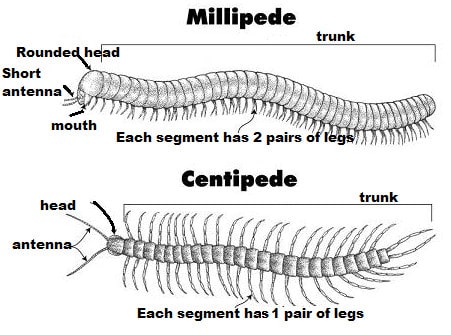
Adult centipede has 30 legs. It is born with only 16 legs and their number increases with every molting. By the way, this can help you determine the age of the centipede and distinguish a juvenile from an adult specimen. House centipede can live from 3 to 7 years.
Interesting fact: it moves extremely quickly, lifting its body on long legs, and is capable of speeding up to 40 cm/sec!
What do centipedes eat?
Centipedes are predators. They prey on flies, termites, cockroaches, spiders, silverfish, moths, fleas and other insects. They usually hunt on the walls of the houses, sheds, and basements. They bide their time and then pursue the prey. House centipedes are active day and night, so you can meet them at any time.
How do centipedes get in my house?
These millipedes live under trees and hide under fallen leaves. House centipedes spend winter in secluded places – they crawl into a warm room with enough insects for food. They penetrate into the house through open windows, cracks, and take shelter in damp places (bath, toilet, and basement).
Where do centipedes live?
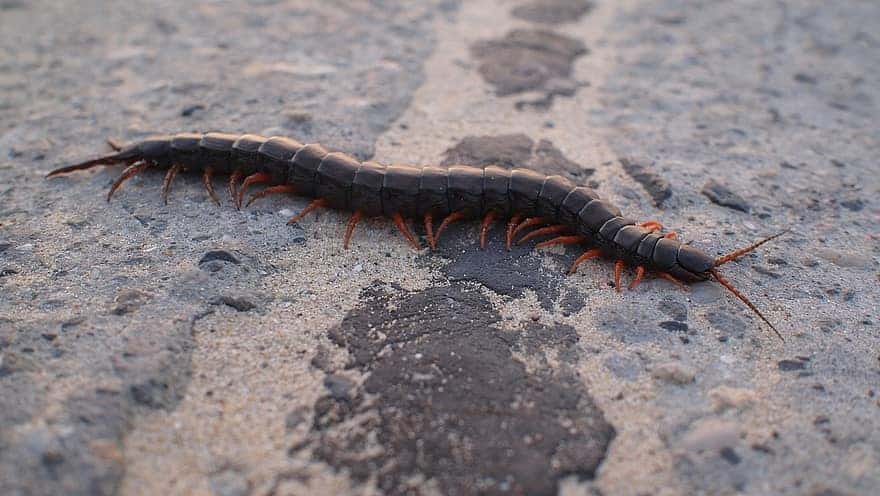
Living quarters are not the main habitat for house centipedes. This is a compulsory measure to escape cold snap in dwellings, basements, and garages. Centipedes live in warm and humid regions, hiding in the foliage. The Mediterranean was their home, and then they spread to Central and Southern Europe, North Africa, the Caucasus, Kazakhstan, and India. In the 19th century, centipedes were brought to Mexico and the Southern United States, and then they spread throughout the continent.
Are house centipedes harmless?
Apart from their hideous appearance, house centipedes doesn’t have other negative characteristics. They do no harm to furniture, food products, clothes, and animals. It is impossible to find the traces of house centipedes activities: they do not make your home look dirty, they do not make sounds, and there is no centipede smell.
Do house centipedes bite?
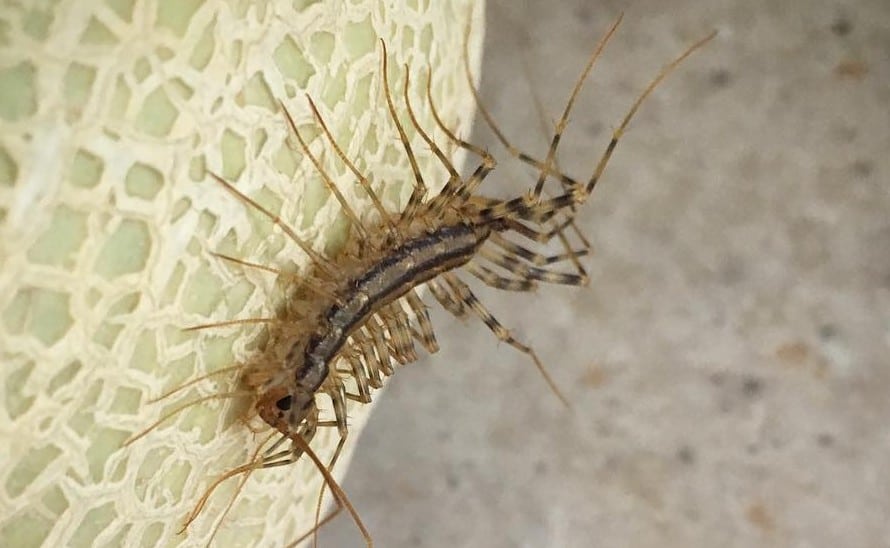
The insect is not aggressive and it tries to hide from people. House centipede stings only to protect itself, but its jaws are so weak that they cannot pierce the human skin anyway. Even if the house centipede bite happens, it feels like a bee sting. It can cause redness and swelling. But a cold compress can help you recover from a house centipede bite quickly.
Interesting superstitions and myths about house centipedes
According to the folk superstitions, the appearance of a centipede bug in house portends a good message or a letter. In fact, they are very timid and careful. House centipedes try not to get caught, so it’s not so easy to see them.
If you believe in superstitions, you will have to wait long for good news and letters 🙂 Another myth breeds fear. People are afraid of centipede crawling into the ear during sleep. There is not a single confirmed case.
The house centipede is afraid of people, and it would not fit into the ear because of its large size and long legs even if it wanted to. If this arthropod appears in the house – do not panic.
It will destroy all other pests that can cause real harm to both people and stuff. In tropical countries, where there are a lot of insects, people protect house centipedes and strongly encourage their presence.
Bugs that look like centipedes
But be careful! The house centipede looks much like other, more aggressive and dangerous millipedes. There is a risk of confusion between the unpleasant looking but harmless arthropod and life-threatening insects. To avoid this, you need to know what scolopendras, silverfish, and diplopods look like. They are also related to millipedes.
Scolopendra has a hard shell and it looks like a long brown or black worm. Its body consists of segments with pairs of short legs (from 30 to 342 legs depending on the species). Its length can reach up to 30 cm.
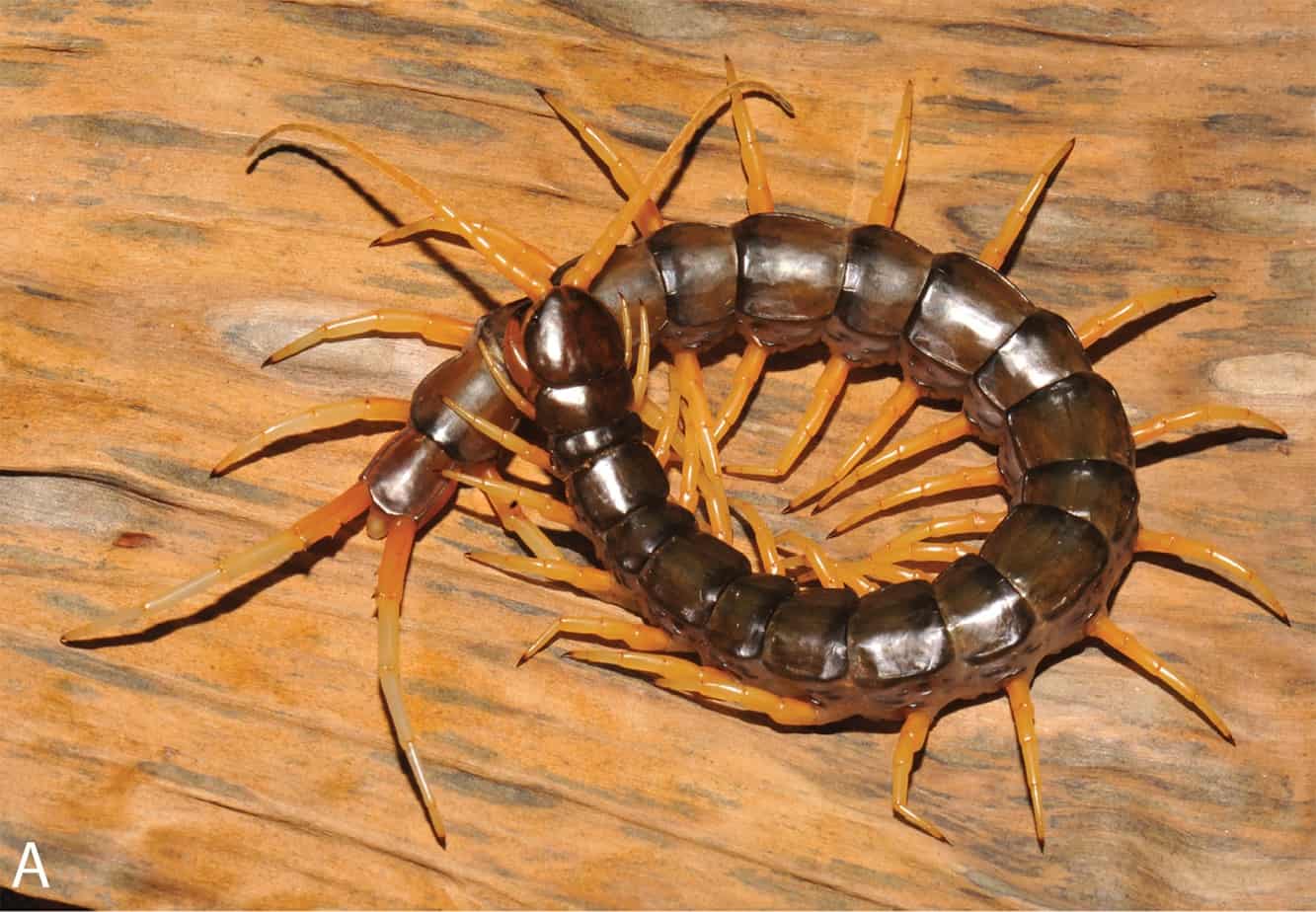
Why are they dangerous?
Scolopendras are venomous. Their bite can cause high temperature, edema, redness, and fever. It causes such pain that it can be compared with the sting of 20 bees at the same time. The bite can lead to fatal outcome only in case of an allergy.
In addition, the legs of the insect end with poisonous spines. Running on the human body, the scolopendra causes irritation and skin burns. They are also dangerous for animals. And birds can get poisoned if they accidentally pick up the insect.
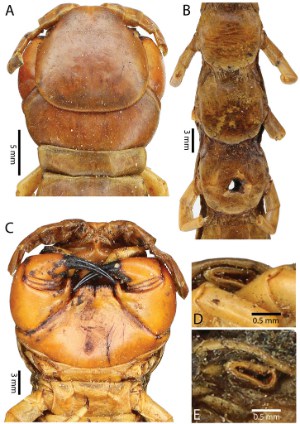
Silverfish is an insect with a yellowish or greenish cone-shaped body 8-20 mm long. Unlike all other millipedes, they live in colonies and multiply rapidly.
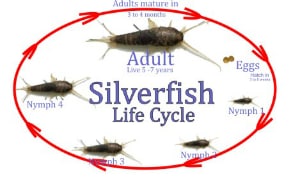
How to get rid of silverfish?
To get rid of insects, you need to make a trap using a can or rolled-up newspaper, into which you should put bait: sugar or starch. A few days later, burn the newspaper with the silverfish that are inside.
Boric acid scattered near the cracks can also frighten them. The insecticide gel is an effective remedy to get rid of insects. And the centipede can also help you destroy silverfish.
Diplopods represent a large number of species depending on the habitat. Their length can reach from a few mm to 10-20 cm. They have 139 pairs of legs. And in California, there are specimens with up to 750 legs. But they move slowly because their legs are short.
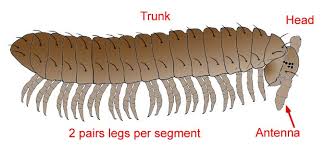
All diplopods have a hard cover. They burrow into the top layer of the soil and feed on plant remains, leaves, and rotten wood. In case of danger, they fold into a ring or spiral protecting the vulnerable abdominal part of the body.
Why are they dangerous?
Diplopods are venomous. Some of them contain hydrocyanic acid, and they use special scent glands to protect themselves against enemies. Poisoning the human causes skin blackening and then flaking. If the poison gets into the eyes, this can lead to blindness.
In Mexico, the Indians used the poison of some diplopods to poison their arrows. And on the island of Haiti, there are diplopods that can spit out poisonous liquid over a distance of 75 cm.
All millipedes belong to the same class, but their lifestyle, habitat and appearance vary. In order not to confuse a harmless and even useful centipede with its dangerous venomous relatives, you must clearly remember the main distinctive features:
- the centipede has a straight body, which is up to 6 cm long, with three longitudinal blue or violet strips;
- long striped legs;
- the back pair of legs is 2 times longer than the body;
- high speed of movement.
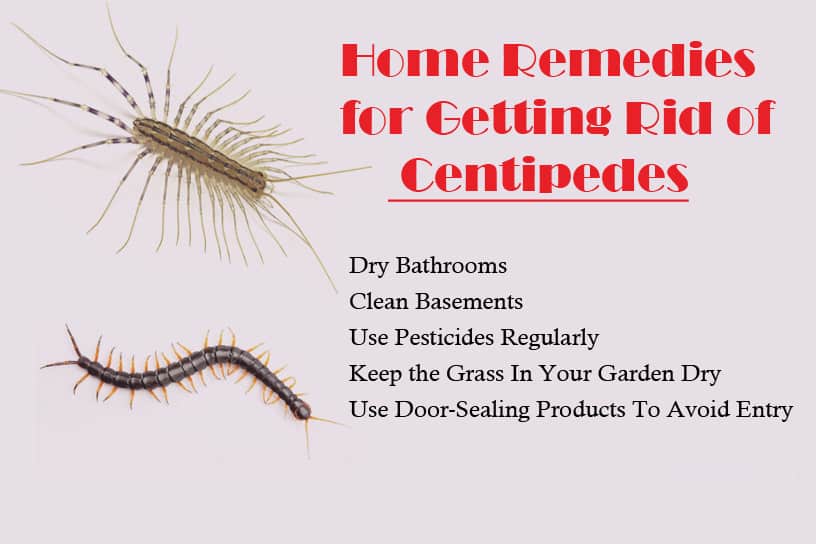
Where do bugs that look like centipedes live?
Scolopendra
Scolopendra are found in warm tropical areas. They do not tolerate the temperatures below 0°C and are killed by frost. In dry and hot weather, their body loses moisture very fast. That is why they live under the ground and in crevices, using already dug holes or constructing their own. There are more than 600 species in the wild, and each of them has its own characteristics and habitat.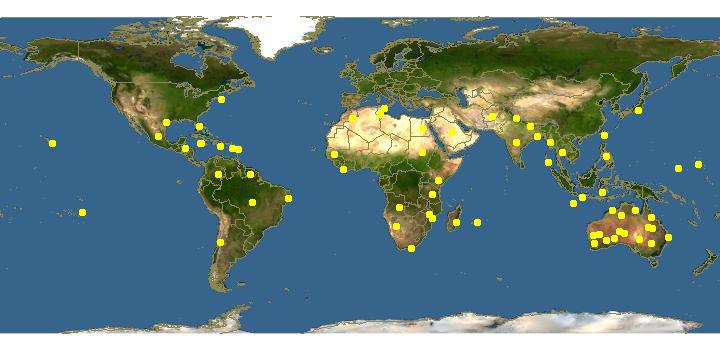
In Australia and South America, there are very bright (red, purple or yellow) and large scolopendras. They are up to 15 cm long. Their mucus causes severe burns. Scolopendra polymorpha is dangerous because it secretes a substance that irritates the human skin.
The largest population of these insects lives in Australia. These millipedes reach a length of 30 cm and can attack lizards and chicks.
[amazon box=”B01N7KSXHX” template=”vertical” tracking_id=”how-to-get-rid-of-house-centipedes-20″ button_text=”Check price on Amazon” button_detail=”https://shareasale.com/r.cfm?b=410159&u=2583381&m=43235&urllink=www%2Edomyown%2Ecom%2Fortho%2Dhome%2Ddefense%2Dinsect%2Dkiller%2Dfor%2Dindoor%2Dand%2Dperimeter%2Drtu%2Dp%2D22028%2Ehtml%3Fsub%5Fid%3D22027&afftrack=how%20to%20get%20rid%20of%20house%20centipedes” button_detail_text=”Check price on DoMyOwn”]
Specifications:
- Active Ingredients: Bifenthrin – 0.05% Zeta-Cypermethrin – 0.0125%
- Item Weight: 11.7 ounces
- Liquid Volume: 1.1 Gallons
- Item Dimensions LxWxH: 8.95 x 12 x 4.88 inches
- Target Species: Ants, Cockroaches, Spiders, Fleas, Ticks, Scorpions, Beetles, Silverfish, Centipedes and Millipedes
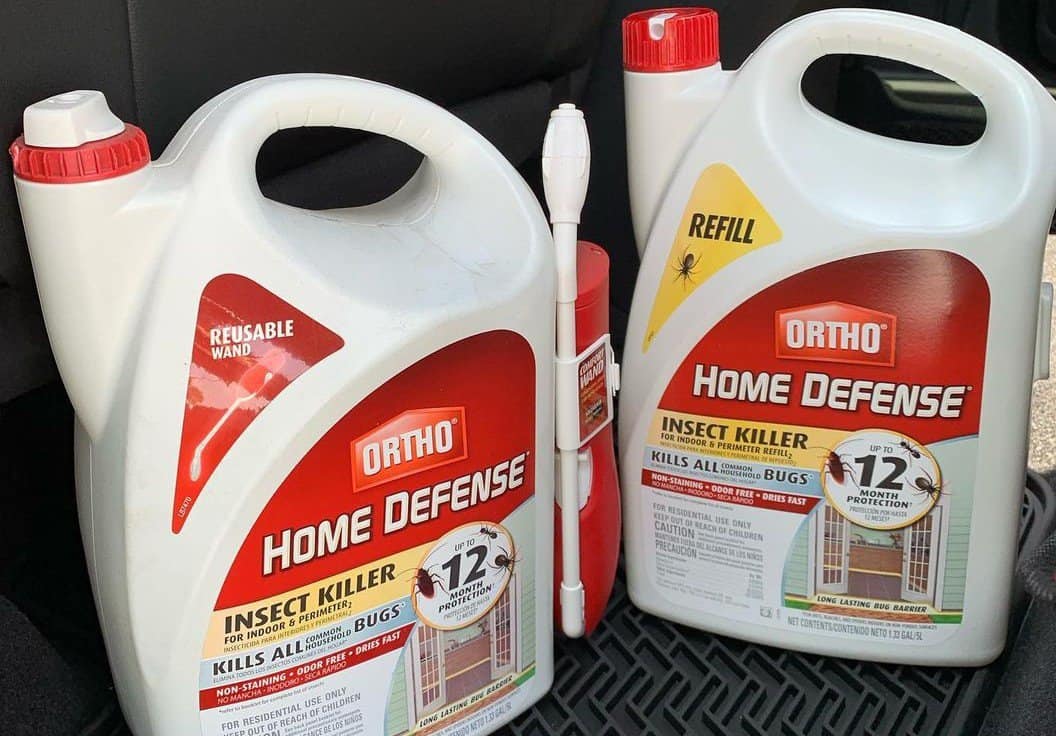
Ortho Home Defense Insect Killer is well-known for dealing with all kinds of large insects. It creates a defending barrier and keeps them from coming to your house with its killing effect. The formula acts pretty fast: in a couple of minutes, the barrier is here! Let it dry so that it could protect your house for the next twelve months. Just disperse it across the perimeter of your home and let it dry.
The spray contains pesticides, so you should be careful when applying it. It’s better to let your children and pets out of the house during the spraying procedure. Anyway, it’s entirely safe for humans and animals once it’s dry. Just wipe a paper towel over the area of application in a couple of minutes to check it for dryness. It’s completely stainless and odorless. You can use Ortho Killer both inside and outside your house.
Outside use can be as much effective, but you may need to repeat the spraying more often in case of rain and other weather conditions. It may not kill a centipede at once (that depends on its size), but it will surely scare it away.
| Pros: | Cons: |
|
|
Silverfish
Silverfish are found in the South Temperate Zone and in the tropics. This insect is spread all over the world, preferring houses and apartments.
Diplodods
Diplopods number more than 7 thousand species. The majority of them is found in Asia, North Africa, and Australia. They differ not only in their habitat, but also in their appearance.
In California, there are diplopods with 750 legs. Very bright gray and yellow specimens live in the southeastern USA. They are 4-9 cm long. Desert species are the native inhabitants of the USA and Mexico. These soil-colored millipedes are 12-14 cm long. The longest diplopods live in the tropics. They are up to 38 cm long. And in Madagascar, there are bright red millipedes that grow 10-12 cm long.
How to get rid of centipedes
The appearance of a house centipede in your dwelling indicates high humidity and the presence of insects it usually eats. They live separately, and if you find one, this is most likely the only specimen in the house. There are some easy ways to get rid of centipedes.
- Catch a house centipede and take it outdoors. Its body and limbs are fragile. The best way to get rid of a centipede is to catch it in the jar not to injure or crush it. The house centipede is useful, and it’s reasonable to keep it alive.
- Check all rooms and secluded places for insects and destroy them if you find any. If there is no food, a house centipede will also leave.
- Check for water pipe leaks and bathroom/kitchen leaking taps. Higher indoor humidity is the best habitat for house centipedes.
- Prevent centipedes from entering the house: install mosquito nets on the windows and vents, repair all the cracks.
- Remove paper, rotten wood, trash and debris from your basement. Insects that attract house centipedes usually live there.
- Remove old dry leaves and twigs from your garden to prevent the emerging of house centipedes.
If there is still a need to kill centipedes, you should know that not all the methods are suitable for this.
- You can use sticky tapes and tanglefoots for catching centipedes.
[amazon box=”B07Q697VZK” template=”vertical” tracking_id=”how-to-get-rid-of-house-centipedes-20″ button_text=”Check price on Amazon” button_detail=”https://shareasale.com/r.cfm?b=410159&u=2583381&m=43235&urllink=www%2Edomyown%2Ecom%2Fterro%2Dpantry%2Dmoth%2Dtrap%2Dp%2D16497%2Ehtml&afftrack=how%20to%20get%20rid%20of%20house%20centipedes” button_detail_text=”Check price on DoMyOwn”]
Specifications:
- Active Ingredient: Hexane – 1.0%
- Item Weight: 10.5 ounces
- Number of Pieces: 12
- Item Dimensions LxWxH: 4 x 3 x 3.25 inches
- Target Species: Cockroach, Cricket, Ant, Spider

Catchmaster traps are the most effective and eco-friendly way of controlling large insects crawling around your premises. The secret of these traps is they’re small and designed to blend into the environment. The insects won’t notice the difference between the trap and landscape until they glue into it. The most effective way of use to set as many traps as you can.
One insect leg caught means a catch and the traps’ edges are sticky enough for that. Besides, small traps cost significantly less than the large ones. The traps are not harmful in any way. They contain only glue, so the catch depends on your strategical abilities to set them in places frequented by centipedes. Besides, these traps can be placed next to food storages and in other areas where pesticide appliance is extremely dangerous.
Recent research indicated that dead insects caught in the glue traps are attractive to their fellow species. Centipedes are carnivorous and happy to feed on other insects including centipedes, which means you don’t even need bait inside your traps.
| Pros: | Cons: |
|
|
- Traps will not work: house centipedes eat only live insects and will not react to the bait.
- Insecticides in the form of gels and powders are not as powerful against these creatures, because the house centipede leads a secluded way of life. And it is very hard to determine where it hides.
The most effective centipede killer is an aerosol insecticide. By the way, there a lot of species and you can use any of them, because house centipedes are rarely poisoned and they do not have immunity to toxic substances.
[amazon box=”B001B1KH1Y” template=”vertical” tracking_id=”how-to-get-rid-of-house-centipedes-20″ button_text=”Check price on Amazon” button_detail=”https://shareasale.com/r.cfm?b=410159&u=2583381&m=43235&urllink=www%2Edomyown%2Ecom%2Fterro%2Dant%2Ddust%2Dp%2D16501%2Ehtml&afftrack=how%20to%20get%20rid%20of%20house%20centipedes” button_detail_text=”Check price on DoMyOwn”]
Specifications:
- Active Ingredients: Deltamethrin – 0.05%
- Item Weight: 1 Pounds
- Formulation: Dust
- Item Dimensions LxWxH: 4 x 4 x 10 inches
- Target Species: Cockroach, Cricket, Ant, Spider, Silverfish, Wasp
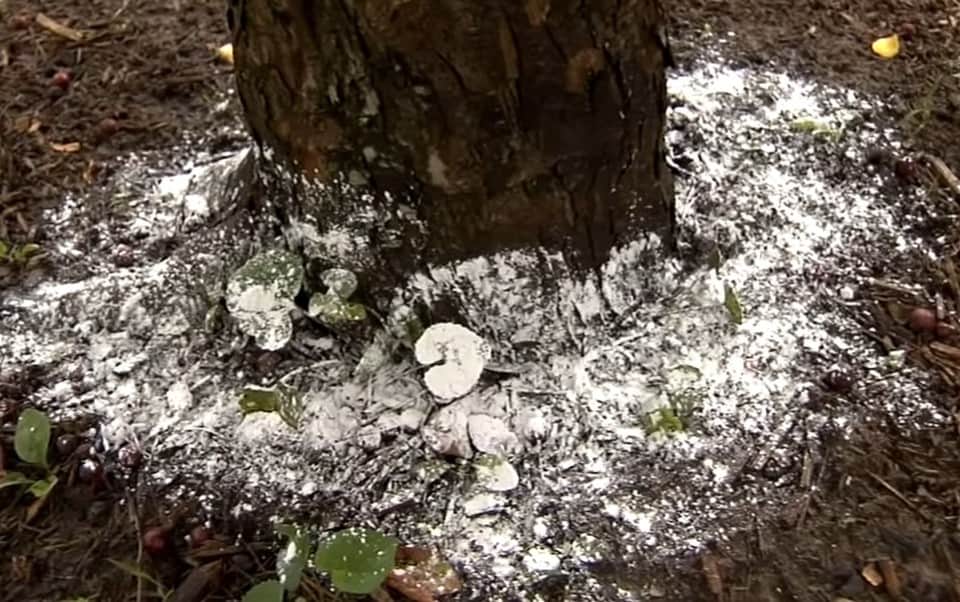
Ant dust has proved to be one of the best means against centipedes. Its action principle is pretty similar to the Ortho Home Defense Spray. Apply it around windows, doors, porches, stairways, and any other places that may serve as centipede entrances to your house. Be very thorough when applying outside the house, spread the highest amount of dust around the foundation as it’s usually the spot where centipedes are active.
It takes three to four days to control the pests with ant dust. Terro ant dust contains Deltamethrin which is highly effective for fighting such large pests as centipedes. The formula is waterproof, so even if you use the dust outdoors, do not worry about the rain washing it away.
The killing effect lasts up to 8 months, so one 16 oz. can of the dust will be enough if your centipede infestation level is not critical. Apart from ants and centipedes, this Terro product is effective for pests of almost every kind and size there is. The formula is poisonous though, so please be sure your pets are kept away from the application area.
| Pros: | Cons: |
|
|
It is worth considering that this arthropod benefits people. So, it is better to just scare it away instead of killing centipedes. Ultrasonic repellers and electronic repellents are used for this purpose.
Preventive measures against centipedes
In order to prevent the appearance of house centipedes, it would be reasonable not to allow them to enter the house. The main condition of not attracting a house centipede is to maintain the average humidity indoors.
For this, it is necessary to take a number of measures:
- Clean the ventilation shaft and install forced ventilation in the bathroom, toilet, and kitchen.
- Check your water supply pipes and plumbing. If there are leaks, eliminate them.
- Install heated floors.
- Make a window in the bathroom (in a private house).
- Ventilate the rooms with high humidity regularly.
- Install a heated towel rail – additional heating will remove condensate.
- Do not dry your clothes in the bathroom.
If these measures do not reduce humidity, you should purchase special instruments and devices to prevent house centipedes appearance. They are divided into the following types:
Moisture absorbers
Moisture absorbers are devices, the aerodynamic shape of which allows air to circulate around the absorbent tablet.
Operating principle
The condensate is collected in a container, protected from spilling and overfilling. The tablets can be easily replaced after a set period of use. Granules and powders (silica gel), which are also easily replaced, can be used as an absorbent in the device. In rooms with an area of 30-40 m2, the absorbent will remain effective for 3-4 months. Some models have an indicator. It signals the need to replace the insert.
Where it is better to use them
It is convenient to use moisture absorbers in the kitchen, basement, garage, and dressing room. Some models represent an attractively-shaped absorbent tablet, inserted into a special container, where moisture is collected. This device can be placed on a table or nightstand and serve as a decoration.
What other absorbents exist
Granules (silica gel) are widely used. They are simply put in a fabric bag and placed in a room, pantry, dressing room or a bathroom. One side of the bag or its small window is made of a transparent material so that the degree of moisture absorption can be tracked. The silica gel beads change their color from blue to pink, which serves as a signal to replace the contents.
Advantages and disadvantages
Moisture absorbers are inexpensive. They do not consume electricity and are safe for humans and animals. The only drawback is that they are used for small rooms and take effect slowly.
Air dehumidifiers
Air dehumidifiers are devices capable to maintain the necessary humidity in any premises. They are divided into industrial (installed in large rooms with high humidity), and household (used in apartments, cottages, garages, basements, swimming pools, saunas, bathrooms, and kitchens). Dehumidifiers are selected according to the power required (from 12 to 300 l/day).
Operating principle
Condensation dehumidifiers suck the moist air in and draw it through a cooling coil with the help of a ventilator. Condensed moisture accumulates in a special container, and the air stream is hotted up by a heat exchanger. Thus, dry and warm air enters the room. Also, you can adjust the outlet air temperature.
Types of air dehumidifiers
Air dehumidifiers are divided into wall-mounted, floor standing, and built-in appliances. For your home, you can choose a compact, light and externally attractive floor standing dehumidifier. You can take it from one room to another as needed. More powerful devices are equipped with wheels for moving.
Wall-mounted dehumidifiers look stylish. You can select the one that best fits into the interior of your room, but their price is much higher.
Wall-mounted or stationary dehumidifiers are usually installed in swimming pool rooms located in houses or cottages. When installing stationary (built-in) dehumidifiers, the air duct is placed in an adjacent room for fresh outdoor air.
Advantages and disadvantages
Depending on the purpose and room size, you can choose models with small power consumption that work through the adapter. A higher power appliance is required for large damp rooms. The range of air dehumidifiers is huge enough to fit every need and budget. The only drawbacks are the price and electricity consumption.
Supply-air units
Supply-air units are new generation devices that cope with any level of humidity but require professional installation. You need to choose a place in the wall, where the device will be inserted, and make a hole. These appliances take the outdoor air, clean it, warm it in winter, disinfect it and bring it into the room.
Fighting excess humidity is a serious matter. It may be necessary to carry out structural refurbishment of the room and install additional systems of ventilation and heating. If the problem is not global, then ventilation regime, air dehumidifiers and moisture absorbers will be enough.
References:
- House Centipedes (PennState Extension):
https://extension.psu.edu/house-centipedes - Centipede Venom: Recent Discoveries and Current State of Knowledge (US Natioanl Library of Medicine):
https://www.ncbi.nlm.nih.gov/pmc/articles/PMC4379518/ -
Biology and Control of Spiders, Scorpions, Centipedes and Millipedes (University of Arkansas System):
https://www.uaex.edu/publications/PDF/FSA-7018.pdf

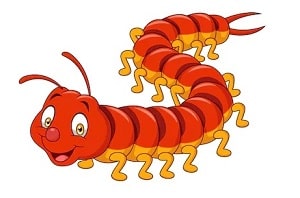

Comments are closed.